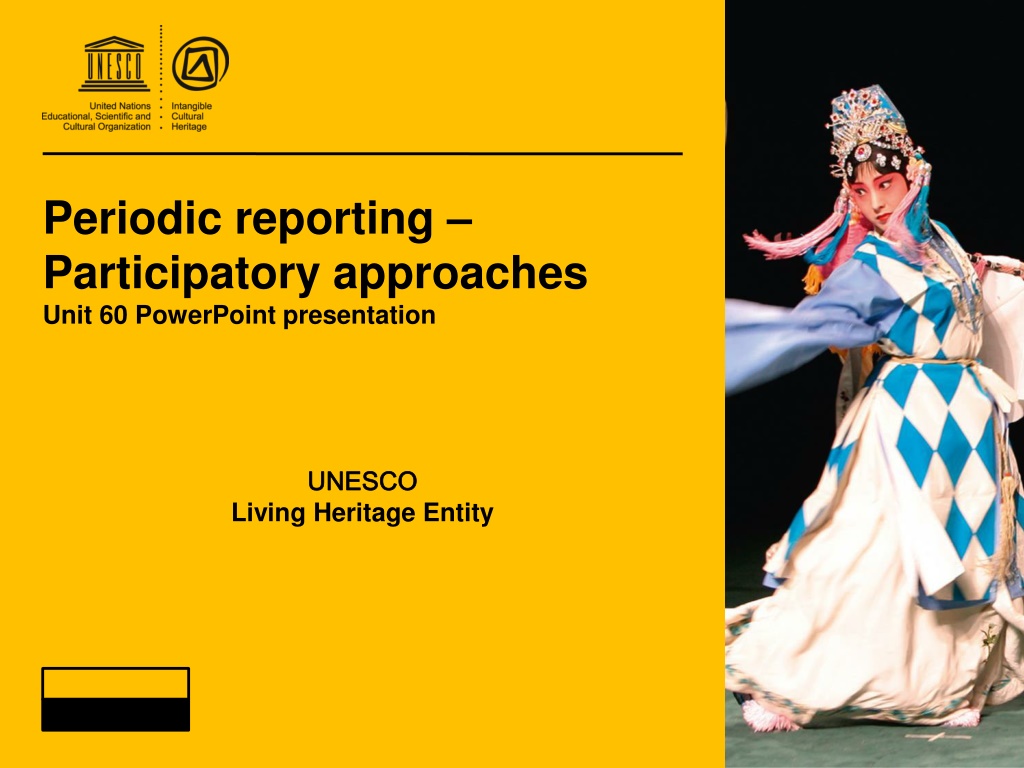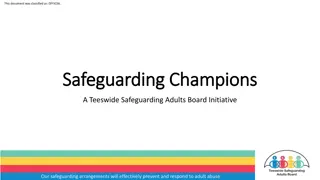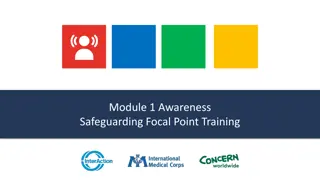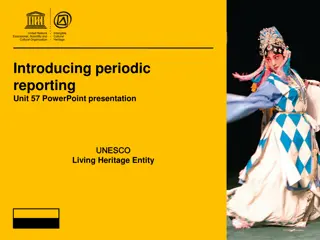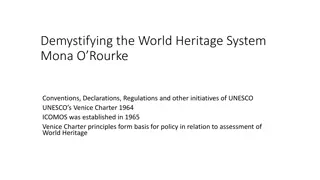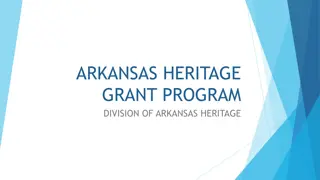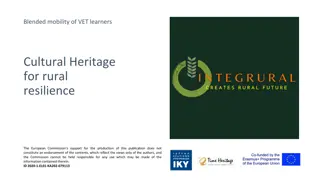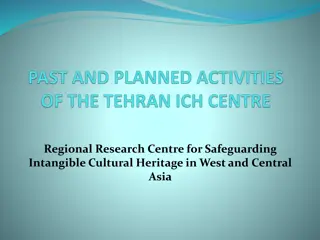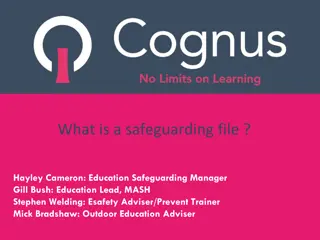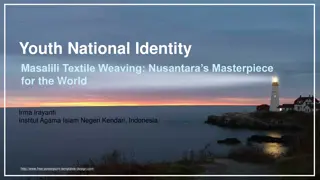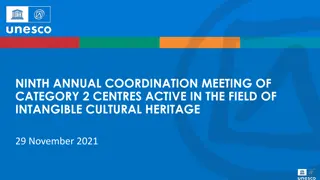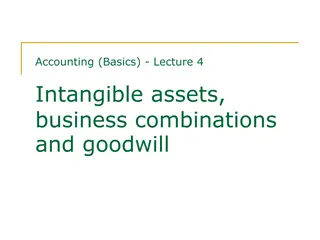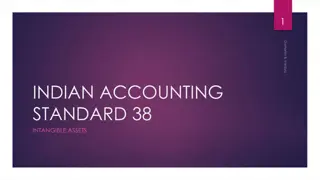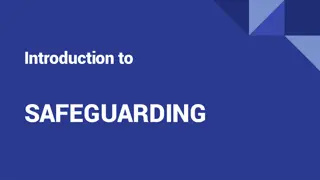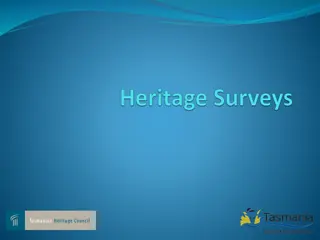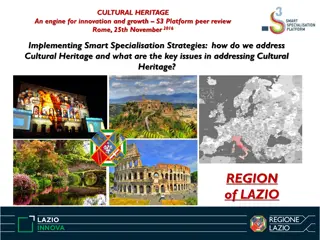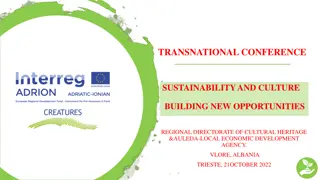Community Engagement in Safeguarding Intangible Cultural Heritage
Encouraging community participation, involving various stakeholders, and prioritizing ethical principles are essential in safeguarding intangible cultural heritage. This presentation explores different interests, roles, and areas of expertise, emphasizing the importance of engaging non-governmental organizations, states parties, and other actors. It also discusses the ethical principles guiding stakeholder involvement and highlights the significance of transparent collaboration, consultation, and informed consent. Effective community engagement is crucial for identifying, inventorying, raising awareness, building capacity, safeguarding, and managing intangible cultural heritage.
- Community Engagement
- Stakeholder Involvement
- Heritage Preservation
- Ethical Principles
- Cultural Heritage
Download Presentation

Please find below an Image/Link to download the presentation.
The content on the website is provided AS IS for your information and personal use only. It may not be sold, licensed, or shared on other websites without obtaining consent from the author. Download presentation by click this link. If you encounter any issues during the download, it is possible that the publisher has removed the file from their server.
E N D
Presentation Transcript
Periodic reporting Participatory approaches Unit 60 PowerPoint presentation UNESCO UNESCO Living Heritage Entity
Different interests, roles and areas of expertise Researchers, NGOs, heritage professionals State agencies Communities, groups etc. Private sector 2
Community participation is encouraged in Identifying and defining ICH (Article 11(b)) Inventorying (Articles 12 and 15) Awareness raising (Articles 14 and 15) Capacity building (Articles 14 and 15) Safeguarding, management (Article 15) Nominations (ODs 1, 2 and 7; forms) International assistance requests (OD 12) Periodic reporting (ODs 157 and 160) 3
Not just communities Non-governmental organizations: States Parties shall involve the relevant non-governmental organizations in the implementation of the Convention in cooperation and coordination with other actors involved in the implementation of the Convention (OD 90) Public or Private bodies/Private persons: The Fund may be used to reimburse the costs of advisory services to be provided, at the request of the Committee, by non-governmental and non-profit-making organizations, public or private bodies and private persons (OD 67) Other actors: States Parties are encouraged to create a consultative body or a coordination mechanism to facilitate the participation of communities, groups and, where applicable, individuals, as well as experts, centres of expertise and research institutes (OD 80) 4
What the Ethical Principles say No one-size-fits-all approach to stakeholder involvement: Ethical Principle 1: Communities, groups and, where applicable, individuals should have the primary role in safeguarding their own intangible cultural heritage. Ethical Principle 4: All interactions with the communities, groups and, where applicable, individuals who create, safeguard, maintain and transmit intangible cultural heritage should be characterized by transparent collaboration, dialogue, negotiation and consultation, and contingent upon their free, prior, sustained and informed consent. Ethical Principle 9: Communities, groups, local, national and transnational organizations and individuals should carefully assess the direct and indirect, short-term and long-term, potential and definitive impact of any action that may affect the viability of intangible cultural heritage or the communities who practise it. 5
Exercise 6
Why is a participatory process important? Governmental bodies may not be aware of all the data available from non- governmental sectors. Essential for checking the accuracy of data provided by governmental agencies. Allows for clarification relating to the data collected. Helps to ensure transparency of the data gathering process. Allows for key priorities, problems, achievements and future challenges to be more easily identified. Reinforces structured dialogue with other stakeholders and avoids only consulting the most influential groups. A wider range of good practices and innovative approaches/examples can be identified through information-sharing. Better and longer-lasting cooperative frameworks can be developed that will feed into future safeguarding activities. [ ] 7
Potential pitfalls of participatory processes Processes that simply give lip-service to participation Exclusion of key groups from the dialogue Lack of planning and forethought Lack of clarity in setting objectives Poor facilitation and lack of necessary training Failure to programme for a reasonable timeframe for multi- stakeholder consultations Lack of necessary flexibility to respond to groups who want to be consulted but were not initially included 9
Some participatory methods Attitude and behaviour change Focus Group Discussion Mapping and Modelling Most Significant Change Outcome Mapping Semi-structured Interview 10
Exercise Case studies 11
Exercise & Role-play 12
Who is needed to prepare the periodic report? The Focal Points responsible for filling out the form should aim to: Ensure a broad multi-stakeholder consultation process Organize the process at the municipal, regional, national and/or federal levels Involve various governmental entities (inter-ministerial consultation) Involve non-governmental actors (non-governmental and civil society organizations etc.). 13
Information sources Some key Ministries/governmental agencies are: Ministries in charge of Culture and Education; Ministries in charge of Higher Education, Research and Innovation; Ministries in charge of Foreign Affairs; Ministries in charge of Employment, Labour and Social Cohesion; Ministries in charge of Youth and Sport; Ministries in charge of Economy, Trade and Industry, Tourism; Ministries in charge of Communication and Digital Economy; Ministries of Public Welfare. Ministry in charge of the Budget Ministry of the Interior (Internal Affairs) Other Ministries and National Agencies (e.g. Environmental Agency, Statistical Institute) serve as resource for complementary information 14
Information sources (2) Useful partners in the data and information gathering process, as well as in validating the responses given in the form, include: Non-governmental organizations with an expertise in the field of ICH. Civil society organizations, including cultural associations related to ICH elements. Other stakeholders such as research centres, centres of expertise and cultural centres; Umbrella organizations directly concerned by the implementation of these measures. Experts and academics active in private foundations or specialized research centres. The private sector (e.g. tourism, textiles, hospitality, etc.) 15
What method to choose? Possible methods: Questionnaires. Interviews (either individually or in a group, face-to-face or over the telephone). A working group. Other? Beforehand, it is important to clearly identify: What information should be sought From where/whom How. 16
Optional Exercise Case study 61 18
Optional case study: Training Programme for the 2005 Convention Source: Participatory Policy Monitoring and Periodic Reporting (Module 3) for the 2005 Convention Facilitator s Guide (UNESCO, 2016) 19
